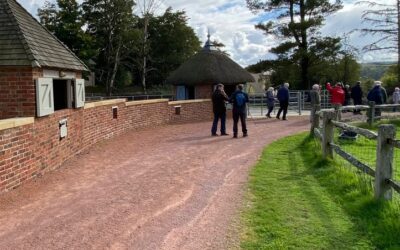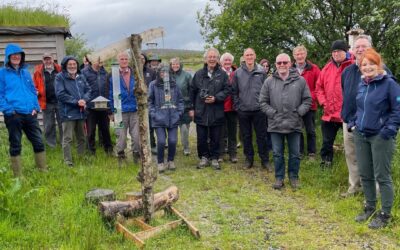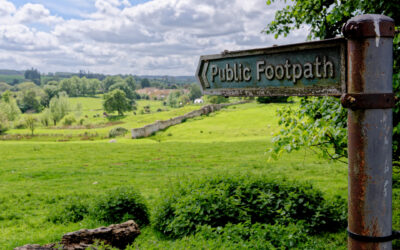Glensaugh, now part of the James Hutton Institute, has been an upland research farm since 1943, one of three then run in Scotland by the old Hill Farming Research Organisation. Lying across the Highland Boundary fault, near Fettercairn south of Aberdeen, the 1000 Ha site climbs to 450 m comprising heather moorland, blanket bog, deep peat and a variety of forestry plantations in addition to well managed, productive grazing on the lower land. Fortunately the Scotia visit benefitted from a bright, dry and sunny day, contrasting with the all too recent wind and rain.
Initially focussed on increasing upland productivity research at Glensaugh has gone through various phases and budget shifts as policy makers changed their minds. It was a test bed for initiatives like deer farming and agro forestry and the signs of various interrupted projects can still be found.
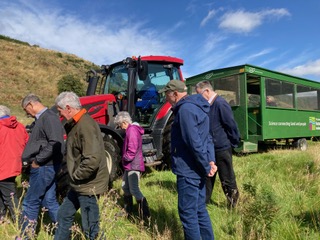
Inspection of Glensaugh grounds
The Climate Positive Farming Initiative
Today the key focus is the Climate Positive Farming Initiative now just over four years into its initial five year programme. Co-ordinated by Professor Alison Hester it is all about investigating a viable future for farming while actively addressing the challenges of global warming and biodiversity loss.
Various projects are in development, each apparently requiring separate funding effort. The peat, once a productivity problem but now recognised for its role in carbon sequestration is now the subject of various trials and restoration techniques. Funding application for that programme was assisted by an innovative partnership with a neighbouring estate offering more degraded peat. But it is just one of the programmes being explored and developed across Glensaugh, including natural water and flood management, where even the role of sward composition is being investigated. The on-farm practicality of green energy production, including hydrogen. A 50kW turbine, a 70kW biomass boiler and an array of roof mounted solar panels all reduce the energy bills and underpin research, alongside the, these days more conventional research, into reducing livestock emissions.
Such a variety of contrasting and sometimes conflicting activity is a real land management challenge. A tour round the estate with Farm Manager Donald Barrie proved it was being met with enthusiasm and passion. Indeed the importance and value of committed people whether researchers or technicians became more obvious as the tour continued.
Livestock and Grazing Systems at Glensaugh
The established upland flock of 320 ewes is Scottish Blackface on a low input low output, system lambing inbye during late April (115%) and then dispersed across the hill. most lambs are sold store with 25% retained as replacements. Much of the 50Ha lower ground grassland supports a productive flock of hybrid “Logie” mules on a system of 1.5ha paddocks with lambs finished on grass by the winter. The same sward fertilised mainly with FYM the paddocks also produce silage and haylage so compromise and flexibility are watchwords.
The closed suckler herd is also undergoing change with the original Blue Greys inherited from the now closed HFRO units well on the way to replacement with Luings using bulls from nearby neighbours the McGowans. Heifers calve indoors at 3 years old with the aim to keep them for 9 more lactations. In summer the cattle graze the higher hill where a previous trial had limed only half the available area. The cattle favour that limed area so there are plans to introduce virtual fencing.
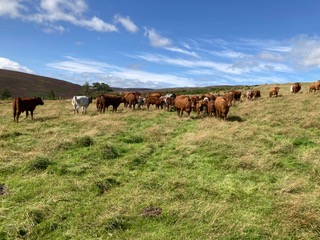
Cattle grazing at Glensaugh
Agroforestry and Woodland Management
Any visitor to Glensaugh can’t ignore the tree cover with abundant old and new plantations. The original Agro Forestry project, forced into redundancy, used Sycamore. It is a species losing favour but proved particularly resistant to recent gales and, 40 years on, offers substantial shelter. However much of the new planting is native hardwoods, in particular oak which has grown exceptionally well this year. Donald Barrie laid great store on controlling any competition around new planting where Bracken is a major problem. In the absence of Asulox he used spot applications of glyphosate which has proved effective. Nevertheless he questioned the labour required to manage small areas of woodland on a conventional farm where any skills and enthusiasm might not match that of his own team.
From those early years of research farmed Red Deer remain at Glensaugh where they make good use of grazing other stock ignore. The stabilised herd of 90 Hinds is 94% productive and easily managed. Stag calves are sold as stores with hinds either retained or finished on farm. However the marketing of farmed venison is challenge with only one oversupplied outlet Dovecot Park, able to dictate terms. This year’s crop of stock due for slaughter cannot be taken until next February and so competes for grazing with the Hinds and this year’s calf crop and all the other livestock.
To Castleton Farm
Similar issues with market access were aired at the visit to Castleton Farm where, alongside the A90 north of Laurencekirk, the innovative Mitchell family run an outstanding food and soft fruit business alongside a Farm Shop, but where polytunnels lie empty at this time of year as supermarkets source cheaper strawberries abroad.
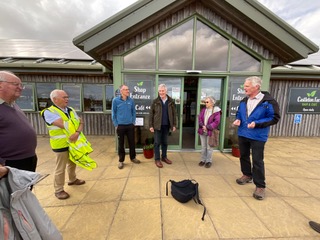
Meeting outside the Casltleton public shop
Originally a dairy farm the conversion to soft fruit gained pace in 1999, originally with strawberries and raspberries but now including blueberries, blackberries and cherries. With a staff of up to 550 and from a modern, high-tech pack-house they supply many of the major multiples, one of which was carrying out a “no notice” audit during the Scotia visit. Now run by award winning husband and wife partnership Ross and Anna Mitchel the group were hosted by father Murray, the pioneer.
Murray explained the farm is some 1400 acres in size with 420 dedicated to fruit while the rest grows cereals or rents out acres for vining peas. There is increasing emphasis on regenerative husbandry with virtually no ploughing and attention paid to soil improvement. Straw is either incorporated or left standing after stripping the heads. Meanwhile, since 2000 and the establishment battles with Inland Revenue over their place in the farming operation the use of polytunnels has become increasingly sophisticated. Fruit is picked every two days from benches presenting berries at waist height, grown in Coir bags or containers and using dribble irrigation. Heating and automatic ventilation is installed in some to stretch the season.
The soft fruit story is one of continuous innovation within a highly competitive market place. While much of the production goes to supermarkets local Scottish outlets and food businesses are not ignored. Castleton was an early pioneer of blueberries and now sells 9 million punnets a year although varieties have evolved to suit modern handling methods. Meanwhile cherry yields have been boosted by planting trees at an angle, an idea learned in New Zealand. The farm now also carries out its own propagation programme to lower costs and reduce disease risk.
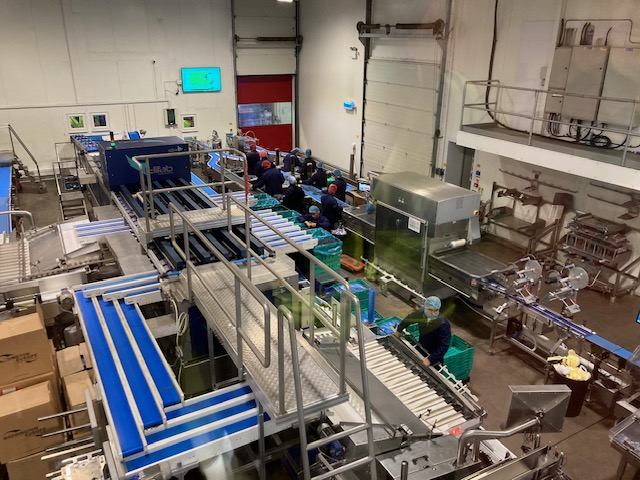
Staff working the fruit processing floor at Castleton
Castleton’s Global Reach and Innovation
But innovation never stops. The company now air freights fruit to high value markets in Dubai, Singapore and Tokyo. Castleton has also established a reputation for its own award winning food products from Ready Meals to home-made sweets, jams and chutneys with a bottled strawberry tart glaze a particular favourite. The latest to win prizes is a Hemp Oil Mayonnaise produced from home grown hemp which as well as being a carbon negative crop offering health benefits has also been shown to be a tremendous soil improver.
In a sector where labour supply can be an issue Murray believed Castleton was in a reasonably good position. Much of the present workforce is now recruited from the various “Stans” with Russian a common language. However, like many others in the industry, a variety of nationalities have worked on the farm over the years and some now fill management rolls after marrying and settling in the area having started from nothing. Something the Mitchells are proud of.
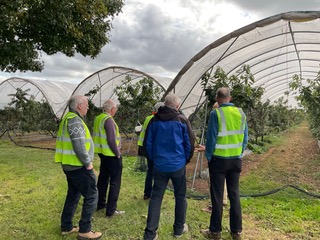
Viewing Castleton cherry trees growing in polytunnels
While the visit to Castleton was time limited it was inspiring and intriguing. Nothing about the international soft fruit sector is simple but this Kincardineshire business in the heart of Sunset Song Country has obviously been making its mark for decades. Mention must be made of the excellent meal in the restaurant and farm shop where the footfall confirmed the businesses reputation.
